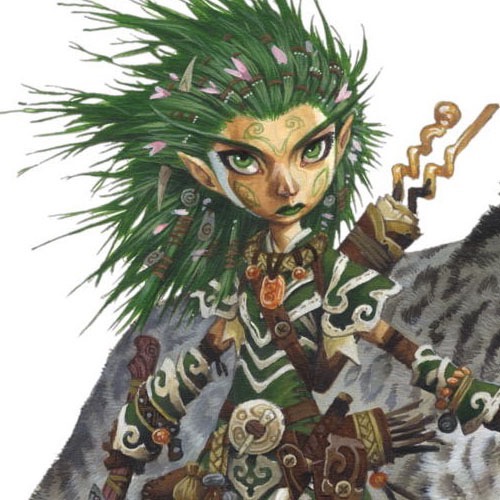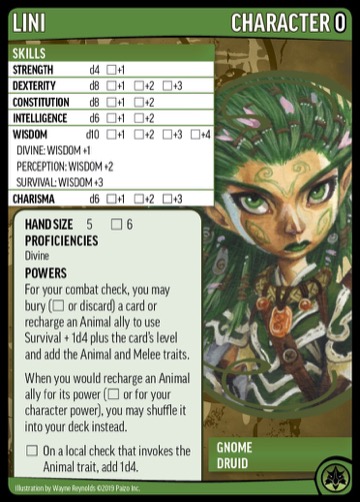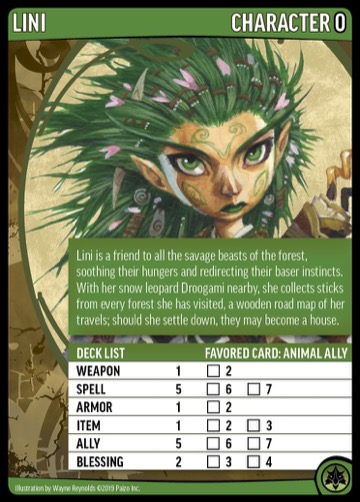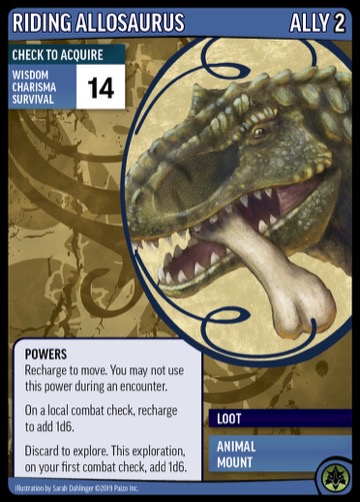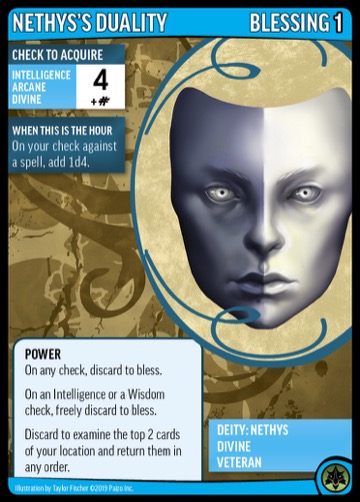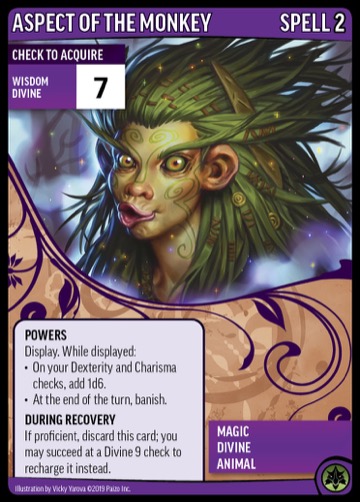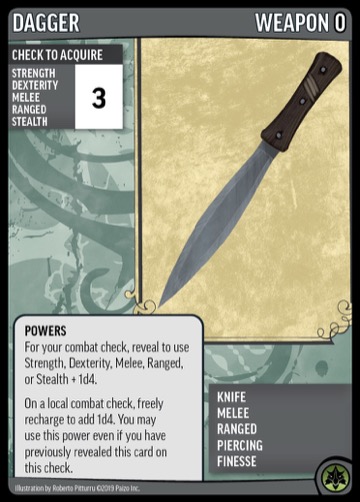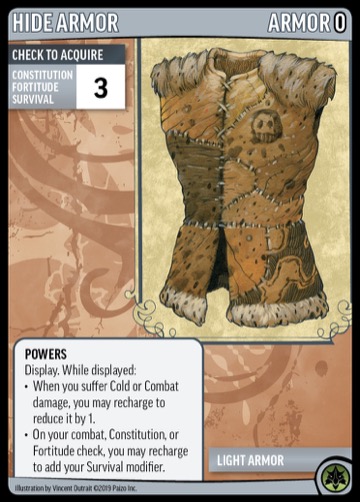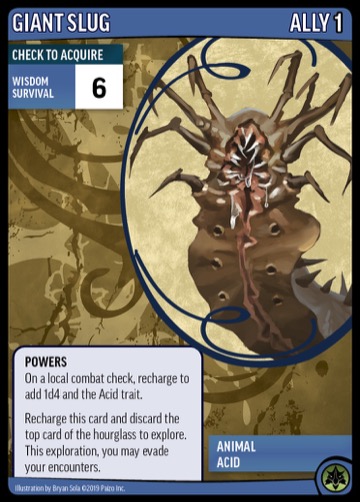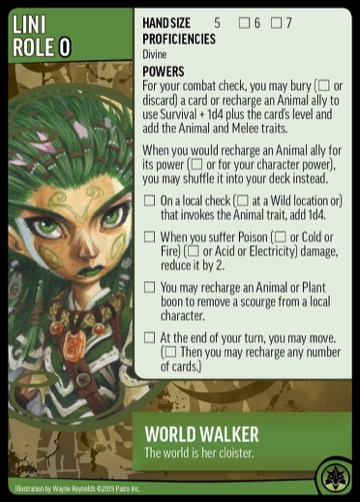Though I’ve seen all four of the quick-start characters in action, Lini’s the one that I’ve been playing through the Core Set adventures, and so this strategizing has all been firsthand. I’ve discovered that she’s a more nuanced character than she was in the original Pathfinder Adventure Card Game sets: better balanced, and so requiring more thoughtful play. Which is all for the best: the classic Lini made everything a bit too easy.
So here are my thoughts on playing Lini, the second of the Quick-Start characters from the Core Set—and here’s some discussion on what “invoking the Animal trait” really means. You’ve very likely got it wrong: we did for our first few games, before I sat down to write this.
Once again, you can see Keith Richmond’s article on Lini for more on how the character has evolved.
Shannon Appelcline
Game HistorianCore Set Lini
Best Skill: Wisdom (d10)
Character Type: Warrior, Healer, Divine
Skills. Lini only has three “subskills”—Divine, Perception, and Survival—but they’re all under her d10 skill, Wisdom. Of those skills, Perception and Survival are the rarest, being featured on only three Core Set characters each. Harsk has both of them (along with Fortitude and Ranged), making them a somewhat poor pairing for an adventuring party, due to the overlap.
Weaknesses. Lini’s biggest weakness is her d4 Strength. Given that she also lacks Melee and Ranged skills, and starts with just one weapon card, she could end up rolling a horrible d4 in combat… if not for her “wild shape” ability: the power that lets her recharge or bury a card to use Survival + 1d4 instead. So this weakness isn’t nearly as problematic as it is for other d4 Strength characters, such as Lem.
Cards. Besides having just a single Weapon, Lini is also short on items (1) and blessings (2). The latter means that she’ll have to find other ways to explore multiple times—a critical ability for all characters. Allies (5) are her best option: she should make sure to collect allies that permit exploration... provided that they have the Animal trait.
Allies. Lini should collect Animals!! (For more, see below.)
Blessings. Nethys’s blessings are probably the best for Lini, as they can bless her Wisdom (and so Divine, Perception, and Survival). Alternatively, Erastil will bless just her Survival.
Spells. Because Lini has both a Divine proficiency and plenty of ability to do damage via means other than spells (namely, her wild shape power), she should stock up on healing spells; this will make her one of the strongest healers in a party, overshadowed only by someone like Kyra, who has a healing-oriented power feat. Take special note of Aspect of the Monkey, the only Animal spell in the Core Set.
Weapons. Lini needs to watch for Dexterity weapons that do not require proficiency. Her starting Dagger actually isn’t bad, since it can be recharged for 2d4. Crossbows are another good choice.
The Power of Animals
Lini’s best powers center around the use of Animal allies, which serve a variety of purposes. That is why you want to fill her ally slots with Animals (which is how her default deck is laid out) and advance to the max of 7 ally cards as quickly as possible.
Take +1d4 to Animal Invocations as Your First Power Feat. Of Lini’s three basic powers, the best is obviously the +1d4 to local checks that invoke the Animal trait. This can be used whenever she activates her wild shape power, whenever she acquires an Animal, whenever she fights an Animal, whenever she plays an Animal to determine the skill she’s using, and whenever her friends at the same location do these same things. It’s very versatile, and it’s a cooperative power. (In contrast, her least useful power is the one that lets her discard instead of bury when using wild shape with a non-Animal card. That’s a desperate last resort, so no need to make it cheaper.)
Clarification: What Invokes the Animal Trait? The “invoke” rule is one of the most confusing in the PACG. Page 9 of the Core Set rules tersely defines it by saying: “A check invokes a trait if it has or is against a card that has that trait. A card invokes a trait if it has that trait. A bane also invokes a trait if it deals only damage of the type that matches that trait.”
This means that the skill you’re using invokes its traits, as do any it references (e.g., Wisdom and Survival are invoked if Lini uses her “Survival: Wisdom +3” skill) and the card you’re facing invokes all of its traits (e.g., Acid and Animal when you’re trying to acquire a Giant Slug, and Poison and Animal when you’re fighting a Giant Toad). Then there’s the special case of a bane adding an exclusive damage type as a trait. And that’s it.
Well, that’s mostly it. Two more special cases appear on page 11 of the Core Set rules: you always add your character’s trait (e.g., Lini always adds Gnome and Druid), and you add the traits of a card you play if and only if it’s a “For your … check” card, like most weapons and Attack spells, which essentially replaces your skill with a card (e.g., when Lini plays a Deathbane Light Crossbow for a combat check, she would invoke Bow, Ranged, Piercing, and Magic).
There’s one last situation when traits are invoked: if a card, power, or scenario rule specifically says to add traits as part of its special effect text (e.g., Lini’s wild shape ability explicitly invokes the Animal trait).
Here’s a chart of all the traits that are actually invoked during a check:
Player Invokes Challenge Invokes Character Traits Oppositional Card Traits Skills Used or Referenced Exclusive Damage Type “For Your … Check” Card Traits Special Effect Traits Effect Note what’s not included here: you don’t invoke the traits of cards played into a check other than a “For your … check” card or the oppositional card. So, if someone plays a support spell like Aid or even Venom Blast in a support role, it doesn’t invoke its traits; if someone plays a blessing, it doesn’t invoke its traits; and most tragically, if Lini plays a support Animal, it doesn’t invoke the Animal trait (or anything else).
Use Wild Shape. Lini’s best combat ability is her wild shape, which allows her to bury a card or recharge an Animal ally to fight at Survival + 1d4 + the card’s level. This has a starting value of 1d10 + 3 + 1d4 + card level, for a range of 5–17 + card level and an average of 11 + card level. Compare that to her starting Dagger at Dexterity + 1d4 (+1d4 if recharged), which is 1d8 + 1d4 (+1d4). That totals 2–12 (3–16 if recharged) or an average of 7 (9.5 if recharged).
Not only is the wild shape better, but it’s easier to pump up, with the +1d4 power feat immediately improving its range to 6–21 + card level and its average to 13.5 + card level. Keep an eye out for anything that could improve your Wisdom or Survival, making wild shaping even better (and note that you can always add in your Hide Armor to give yourself another +3 to combat by double-adding your Survival modifier).
Obviously, you always want to recharge Animals, not bury cards, to invoke wild shape. Recharging helps to cycle your deck, while burying cards thins it and makes you more vulnerable. (Here’s another reason to recharge Animals: you can happily declare “I turn into a giant slug” as you play the appropriate card.)
Collect the Right Animals. Consider carefully if you want Lini to be a combat monster or more versatile; this should largely depend on the composition of the rest of your party. If you want Lini to be one of your main fighters, collect Animals like Droogami and Riding Allosaurus, which can add to her combat stats. If you want Lini to be more versatile, then instead go for Animals that add to other skills, like the Raccoon that adds to Dexterity or Disable. In the latter case, you’ll still be recharging the Animals to wild shape, but during the narrow window that they’re in your hand, you might be able to use them for something else instead. (But don’t hold onto an Animal for a specific non-combat check unless you know it’s in your near future, such as a check to close your location. Else, you’ll just be clogging your hand when you could be cycling it.) Whichever the case: collect Animal allies exclusively and improve them as quickly as you can. Lini should never have non-Animal allies, not even seductive Loot allies.
The Lini Roles
Overall, the Wild Whisperer seems like the role that builds better on Lini’s innate abilities, but World Walker is a nice alternative if healing or movement are missing from your party.
Wild Whisperer. This role improves Lini’s already great power of Animals, allowing her to bring both her wild shape and her Animal invoke bonus up from +1d4 to +1d6 and also allowing her to heal Animal cards (albeit at the cost of something else). That makes it a good choice if you’ve been able to build out Lini’s Animal allies well. The ability to turn Strength into a d10 offsets Lini’s main deficit, which is good if it’s been causing you problems (and the fact that you recharge a card to do so makes this power even better, because that can again help you cycle cards that were clogging your hand). Finally, the power feats that add Acrobatics and Fortitude skills are nice if they’ve been lacking in your party. (That’s more likely for Acrobatics, as it appears on only three Core Set characters.)
World Walker. This role is much more defensive, giving Lini elemental defenses and the ability to remove scourges. If your party is light on healing for either damage or scourges, this might be a good choice. Meanwhile, the ability to move at the end of a turn is nice if your party is missing Amiri—see the upcoming fourth article in this series for why that’s great!
PACG Core Set Class Strategy #2: Lini the Druid
Friday, October 18, 2019
